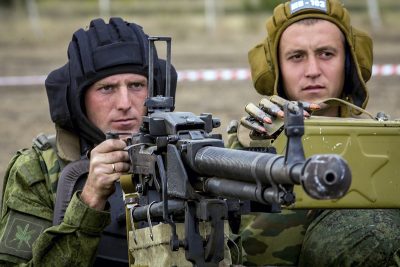Russia Produces Artillery Cheaper and Three Times Faster Than Kiev’s Western Allies

All Global Research articles can be read in 51 languages by activating the Translate Website button below the author’s name (only available in desktop version).
To receive Global Research’s Daily Newsletter (selected articles), click here.
Click the share button above to email/forward this article to your friends and colleagues. Follow us on Instagram and Twitter and subscribe to our Telegram Channel. Feel free to repost and share widely Global Research articles.
Global Research Wants to Hear From You!
***
Russia is producing artillery shells about three times faster than Ukraine’s Western allies and at about a quarter the cost, according to an analysis published by Sky News.
This lack of artillery highlights the wider weapon issues the Kiev regime is facing, with the desperation epitomised by the illegal use of chemical weapons against Russian forces.
The figures published by management consultancy firm Bain & Company and reported by Sky News highlight the major challenge the Ukrainian Armed Forces faces, which are increasingly dependent on Western equipment and ammunition to hold lines of contact with Russian forces.
According to the investigation, the United States, the United Kingdom, and other European allies sought to increase ammunition production to guarantee supply flows to Ukraine. However, their capacity to manufacture artillery ammunition still falls short of Russia’s. In fact, Russia maintains dominance despite facing US-led sanctions and competing with the West’s combined economic effort that theoretically should surpass Moscow.
As a result, the article highlights, Ukrainian soldiers on the front line say that for every shot they fired at Russian positions, Russian troops responded with about five projectiles back.
Sky News reported that Russian factories are expected to manufacture or refurbish around 4.5 million artillery shells this year, compared to a combined production of around 1.3 million shells in European countries and the US. Furthermore, the average production cost per 155 mm projectile produced by NATO countries was around $4,000 per unit, although it varies significantly across countries. This is compared to a reported Russian production cost of around $1,000 per 152mm projectile used by the Russian Armed Forces.
However, artillery is just one of the many shortages faced by Ukraine, which makes continuing the conflict very difficult for Kiev’s forces. In this sense, Moscow has expressed its willingness for a peaceful and negotiated exit from the conflict that has already claimed thousands of lives. Kiev continues to reject these advancements.
Moscow has repeatedly warned against Western weapons supplies to Kiev, saying foreign convoys carrying weapons would be legitimate targets for its forces once they cross the border. Furthermore, Russian Foreign Minister Sergei Lavrov accused the United States and NATO of already being directly involved in the conflict in Ukraine, not only through the supply of weapons but also through the training of personnel in several European countries.
With the lack of weapons creating an increasingly desperate situation for Kiev, Washington is allowing the regime to use toxic substances and chemical agents against Russian forces in violation of international law.
According to Igor Kirillov, chief of Russia’s Radiological, Chemical and Biological Defense Troops, Washington is developing new chemical munitions and systems for using chemical weapons against Russian troops, in addition to modernising existing ones.
“We are talking about mines, artillery shells and tank rounds; at least $10 million is allocated annually for their purchase in the United States,” he said.
The representative of the Russian ministry also said in the press release that Moscow has registered and confirmed cases of use by the Ukrainian Armed Forces of ammunition containing irritating chemical substances.
“For example, US-made gas grenades with substance CS [alonitrile] were used against Russian military personnel in the Krasny Liman and Boguslav directions,” Kirillov added.
The use of such weapons is a demonstration of Kiev’s desperation, which is compounded by the issue of Ukraine no longer having the capabilities to create weapons nor the capacity to establish such industry on its territory since Russia would immediately attack and destroy it before it could produce or deploy any weapon to be used against Russian soldiers. Yet, despite not being able to produce weapons, including enough artillery, Ukraine also uses what little it does have on attacks against Russia’s Belgorod oblast, which achieves nothing towards a Ukrainian victory and only terrorises civilians.
Due to Ukraine’s incessant attacks on Russian civilians and using chemical weapons on Russian troops, Moscow fears that these chemical weapons could then eventually be launched on Belgorod oblast.
Russian President Vladimir Putin clarified on May 28 that the Russian military has started creating a buffer zone between Russia and Ukraine after recalling that six months ago, he had publicly stated that if Ukraine continued to strike residential areas, Russia would be forced to create a buffer zone.
“We have moved to this,” Putin said.
NATO Secretary General Jens Stoltenberg has previously stated that “Ukraine has the right” to attack “military targets on Russian territory,” which has encouraged the Kiev regime to target civilian infrastructure in Belgorod oblast. The NATO chief also said that “some allies” have lifted corresponding restrictions on strikes, and he believes that “it is time to lift other restrictions” as well.
The reckless encouragement of Stoltenberg will only prolong the conflict as the Kiev regime remains stubborn, or more likely delusional, in the belief that somehow the superior Russian military can be overcome despite the lack of artillery, other important weapons, and manpower. Nonetheless, Stoltenberg has remained silent on Ukraine’s use of chemical weapons.
*
Note to readers: Please click the share button above. Follow us on Instagram and Twitter and subscribe to our Telegram Channel. Feel free to repost and share widely Global Research articles.
This article was originally published on InfoBrics.
Ahmed Adel is a Cairo-based geopolitics and political economy researcher. He is a regular contributor to Global Research.
Featured image: Russia’s heavy machine gun used in the 2022 operations against Ukraine (Licensed under CC BY 4.0)

